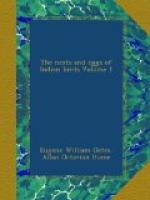“Though I have not as yet discovered the breeding-place of this bird, I think it as well to put on record what little I have noticed, in the hope that it may be of assistance in eventually finding out where it goes to breed. I began watching the birds in the middle of April, and every week shot one or two and dissected them, but did not perceive any decisive signs of their breeding until the 10th May, when I shot two males, both of which showed signs of being about to breed at an early date. Again, on the 15th May, out of seven that I shot in a flock, six were males with the generative organs fully developed; the seventh was a young female in immature plumage, the ovaries being quite undeveloped. The birds were feeding in the bed of a dried-up swamp, along with flocks of Sturnus minor, and were constantly flying in flocks, backwards and forwards, in one direction. Unfortunately, important work called me to another part of the district, and when I returned in a fortnight’s time I could not see one. Where can they have gone? And they remain away such a short time! I have seen the old birds return as early as the 7th July, accompanied by young birds barely fledged, and I should not be at all surprised if these birds are found to breed in some of the Native States on the east of Sind. That they could find time to migrate to the Caspian Sea and Central Asia to breed, and return again by the middle of July, I cannot believe, especially after having found them so thoroughly in breeding-time, while still in the east of Sind. Another suspicious circumstance is the absence of females in the flocks I met with. Perhaps some of my readers may have an opportunity of finding out whether Pastor roseus occurs in the districts lying to the east of Sind in the month of June, as there is no doubt that the breeding-time lies between the 20th May and the commencement of July.”
529. Sturnus humii, Brooks. The Himalayan Starling.
Sturnus unicolor, Marm., apud Jerd. B. Ind.
ii, p. 322.
Sturnus nitens, Hume; Hume, Rough Draft N. & E.
no. 682.
The Himalayan Starling breeds in Candahar, Cashmere, and the extreme north-west of the Punjab. It is the bird which Dr. Jerdon includes in his work as S. unicolor (a very different bird, which does not occur within our limits), and which Mr. Theobald referred to as breeding in Cashmere as Sturnus vulgaris, which bird does not, as far as I can learn, occur in the Valley of Cashmere, though it may in Yarkand.
This Starling lays towards the end of April at Peshawur, where I found it nesting in holes in willow-trees in the cantonment compounds. In Candahar it lays somewhat earlier, and in the Valley of Cashmere somewhat later, viz. in the month of May.
It builds in holes of trees, in river-banks, and in old buildings and bridges, constructing a loose nest of grass and grass-roots, with sometimes a few thin sticks; it is perhaps more of a lining to the hole than a true nest. It lays five or six eggs.




